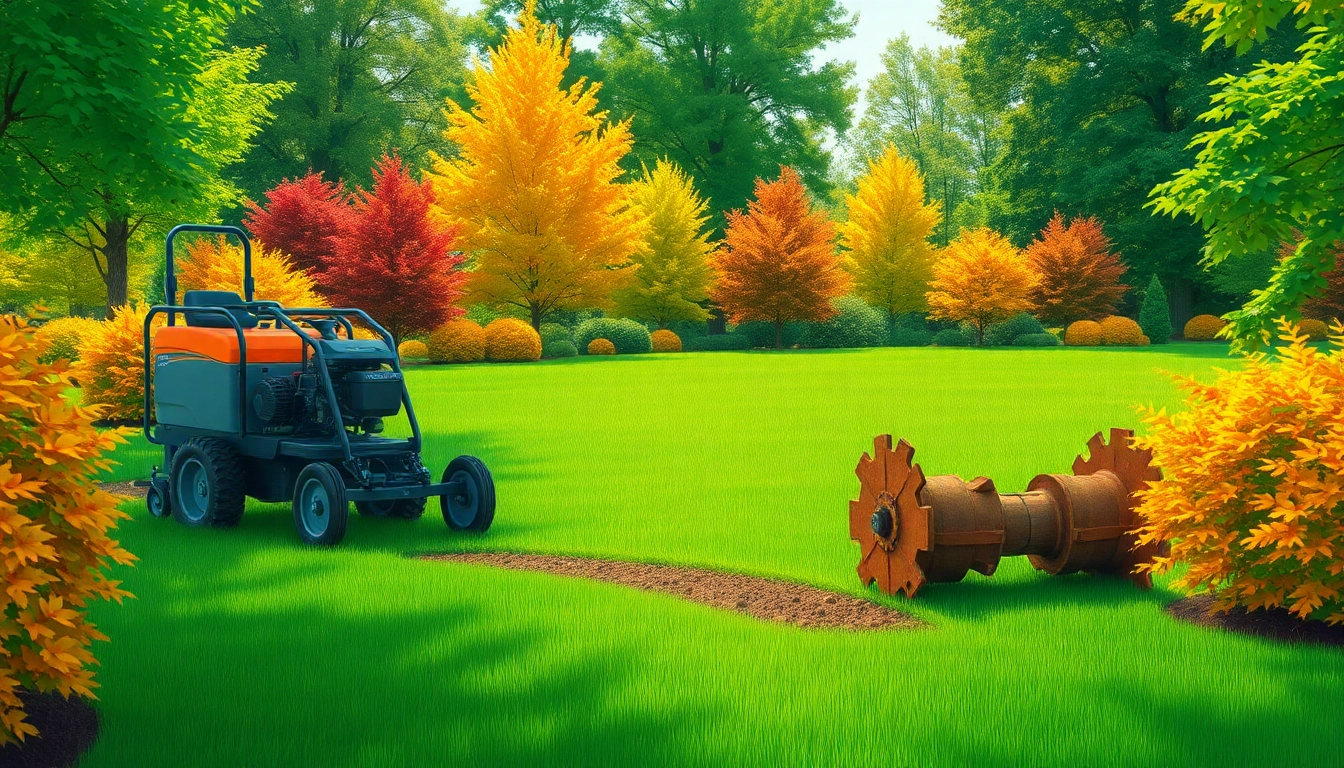Understanding Core Aeration
What is Core Aeration?
Core aeration, often referred to as plug aeration, is a vital process in lawn care that involves the removal of small soil plugs or cores from your lawn. This procedure helps alleviate soil compaction, allowing for better airflow, water infiltration, and nutrient absorption. With a lawn aerator, holes measuring approximately ½ to ¾ of an inch in diameter are created, facilitating enhanced growth conditions for your grass. Essentially, core aeration is akin to giving your lawn a breath of fresh air, which is crucial for its health and vitality.
Importance of Soil Health
Soil health is foundational to a thriving lawn. Healthy soil supports a vibrant ecosystem that fosters plant growth by providing essential nutrients, retaining moisture, and allowing for proper drainage. Unfortunately, factors such as heavy foot traffic, drought, excessive rainfall, and thatch build-up lead to soil compaction, which restricts air, water, and nutrient accessibility to the root zone. By regularly implementing core aeration, one can effectively combat these adversities, promoting robust grass growth and resilience against pests and disease.
How Core Aeration Works
The mechanics of core aeration are relatively straightforward. A specialized machine or tool, known as a core aerator, removes plugs of soil from the lawn, typically distributing them evenly across the surface. The result is a series of holes that penetrate the soil and relieve compaction. These perforated spaces not only enhance the exchange of oxygen but also create pathways for moisture and nutrients. After a core aeration treatment, soil microbes benefit as decomposed organic materials are exposed, further enriching the soil and improving lawn health.
Benefits of Core Aeration
Improving Soil Structure
One of the primary advantages of core aeration is the significant improvement in soil structure it offers. As compacted soil is aerated, the pore spaces that allow for air and water movement are expanded. This increased porosity helps mitigate the challenges associated with heavy soils, particularly clay, facilitating better drainage and root expansion. A well-structured soil environment encourages deeper rooting, which enables grass to access moisture and nutrients more effectively.
Maximizing Water Penetration
Water’s ability to penetrate the soil is critical for plant health. Compacted soils suffer from poor water infiltration, leading to superficial watering needs that encourage shallow root systems. Core aeration breaks down these compacted layers, promoting deeper water penetration. This not only enhances irrigation efficiency but also minimizes runoff, ensuring that water is absorbed where it’s needed most. As a result, the lawn can thrive even during dry spell durations.
Enhancing Nutrient Uptake
In conjunction with improved water penetration, core aeration enhances nutrient uptake within the soil. Fertilizers and other soil amendments can be more effectively incorporated into the soil profile. With aeration, the soil has better access to nutrients available, thus promoting robust grass growth and overall lawn health. The synergy between air, water, and nutrients creates an optimal environment that helps achieve a lush, vibrant lawn.
When and How to Aerate Your Lawn
Best Times for Core Aeration
The timing of core aeration is crucial for reaping its full benefits. For cool-season grasses, early spring or early fall is ideal, as these periods coincide with peak growth seasons. Conversely, warm-season grasses benefit most from aeration in late spring to early summer when they are actively growing. Understanding the growth patterns of your lawn is essential to maximize recovery and benefits.
Step-by-Step Aeration Process
- Preparation: Mow the lawn to a lower height to facilitate easier aeration. Ensure soil moisture is adequate, but avoid aerating a soaked lawn.
- Mark Zones: Clearly mark areas that you want to aerate, avoiding any sprinkler heads or underground utilities.
- Use an Aerator: Choose either a manual or powered aerator and start walking in a systematic pattern across the lawn, ensuring that the aerator overlaps slightly with each pass.
- Leave Plugs: Allow the soil plugs to remain on the surface of the lawn. They will naturally decompose and enrich the soil.
- Follow-Up Care: After aeration, consider overseeding or applying fertilizer to boost the recovery and health of your lawn.
Common Mistakes to Avoid
While core aeration can significantly improve lawn health, several common mistakes should be avoided:
- Ignoring Scheduling: Aerating at the wrong time of year can stress the lawn. Always follow seasonal recommendations based on the type of grass.
- Inadequate Preparation: Failing to mow low and ensure appropriate soil moisture can hinder the effectiveness of aeration.
- Post-Aeration Neglect: Not following up with watering or fertilizing post-aeration can stall recovery and benefits.
Core Aeration Equipment and Techniques
Choosing the Right Aerator
The choice of equipment is vital for effective core aeration. Two main types of aerators are prevalent: spike aerators and core aerators. Core aerators are typically more effective, as they remove soil plugs, while spike aerators only puncture the soil. For home use, the right size and type of aerator will depend on the lawn size and soil conditions. Rental options are often available for those who prefer to aerate less frequently.
DIY vs. Professional Services
Deciding between a DIY approach and hiring professionals can depend on various factors, including the lawn size, the severity of compaction, and personal comfort with equipment handling. While DIY aeration can be cost-effective, professionals bring expertise and reliability, which can be especially beneficial for large or complex lawns experiencing severe compaction or thatch issues.
Seasonal Maintenance Tips
After successfully aerating your lawn, it’s essential to incorporate seasonal maintenance practices that will support long-term health:
- Regular Mowing: Mow your lawn regularly to promote healthy growth and discourage disease.
- Appropriate Watering: Maintain a regular watering schedule, adjusting for rainfall and seasons.
- Fertilization: Use appropriate fertilizers based on soil tests to ensure balanced nutrients.
- Thatch Management: If thatch build-up occurs, plan to dethatch periodically to maintain optimal soil health.
Core Aeration Myths and Facts
Debunking Common Misconceptions
Several myths surround the practice of core aeration. One prevalent misconception is that aeration is only necessary for poorly maintained lawns. In reality, regular aeration is beneficial for all lawns to prevent compaction and maintain health. Another myth is that aeration can worsen soil compaction; however, when done correctly, it significantly alleviates existing compaction issues.
Understanding Aeration Needs
Understanding when your lawn needs aeration can often depend on various indicators. Frequent visible signs of compaction include standing water after rainfall, difficulty in digging into the soil, and unhealthy or patchy grass growth. Homeowners should evaluate their lawn every year or two for these indicators, especially if heavy foot traffic has occurred.
Real Results from Core Aeration
Many case studies support the effectiveness of core aeration in improving lawn health. For instance, lawns that underwent core aeration demonstrated enhanced growth rates and improved color vibrancy compared to untreated areas. Many professional lawn care services report that regular aeration is one of the best investments homeowners can make towards maintaining a healthy, lush lawn.



